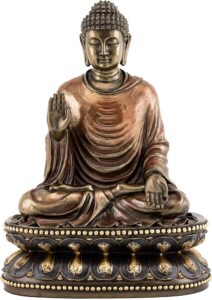
Shakyamuni Buddha, the spiritual founder of Buddhism, was born between the 6th – 4th century BCE and lived in central north India some 2,500 years ago. He was named Siddhartha Gautama and was raised in the region of Shakya. His father was Shuddhodana, King of the Shakya Clan, and his mother, Mayadevi, was known as Queen Maya.
Each year in April, Buddhist temples celebrate Shakyamuni Buddha’s birthday, April 8th, in a special service known as Hanamatsuri or Flower Festival. A Hanamido, a small altar, is prepared for this service and placed in the temple’s sanctuary. The Hanamido is decorated with flowers with a statue in the middle of the infant Buddha. During the service, participants in attendance are invited to come before the Hanamido to pour tea over the statue of the Buddha. Amacha or sweet tea is traditionally used to represent the sweet rain that fell on the day of his birth as told in the story of Hanamatsuri.
The origin of Hanamatsuri comes from the story of Shakyamuni Buddha’s miraculous birth. It is said in this story that prior to the birth of the Buddha, Queen Maya dreamt of a six-tusked white elephant entering her right side. A sage interpreted the dream and predicted that she would have a son who would either become a great king or a great spiritual leader.
As the days neared, Queen Maya made a trip to her parent’s home, as was the custom, to prepare for the birth of her son. On the way, the queen passed by Lumbini Garden in southern Nepal where she saw an array of beautiful flowers and decided to take a rest in the garden. When she went to take a look at a flowering tree, she gave birth to the Buddha. At that moment, sweet rain fell from the sky bathing the newly born baby and flowers began to bloom.
After his birth, it is said that the infant Buddha stood up and took seven steps in each of the four directions, East, South, West, and North. Then pointing one finger up and another finger down he proclaimed,*
“Heavens above and heavens below,
I alone am the World Honored One.”
The seventh step of the infant Buddha symbolizes his transcendence from the six realms of suffering, thus ending the suffering caused by the karmic cycle of birth and rebirth. The term “World Honored One” is an epithet for Buddha.
Siddhartha Gautama was born into a life of wealth and privilege. He lived a luxurious life, married and had a son. However, at the age of 29, he learned of the deep suffering experienced by all people. He then renounced his princely life to seek the truth that would liberate himself and all human beings from a world of suffering. He studied doctrines and began an austere life of ascetism. After six years he gave up his ascetic practices and returned to a normal life. He then began meditating under the shade of a Bodhi tree. One night after seven weeks of meditating, enlightenment came to Siddhartha Gautama. For the next 45 years of his life, the Buddha began his missionary journey giving sermons and teaching the path to liberation and enlightenment. He passed away at the age of 80.

